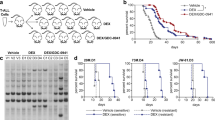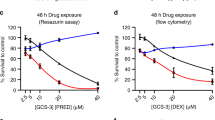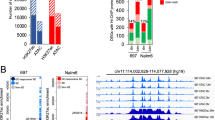Abstract
Alternative splicing of the primary glucocorticoid receptor (GR) transcript, resulting in glucocorticoid receptor alpha GRα, glucocorticoid receptor beta GRβ and glucocorticoid receptor gamma GRγ, may influence glucocorticoid (GC) resistance in childhood leukemia. To test this hypothesis, we determined GRα/β protein and GRα/β/γ mRNA expression levels in 43 initial acute lymphoblastic leukemia (iALL), 10 initial myeloid leukemia (iAML), 11 relapsed ALL (rALL) samples and one rAML sample. The results were correlated with in vitro GC resistance. GRα mRNA correlated with protein expression (ρ=0.39–0.56, P<0.05), but the protein to mRNA ratio was median 2.2-fold lower in rALL than in iALL (P<0.05). GRβ mRNA was median 137-fold lower than GRα mRNA and correlated with GRα mRNA expression (ρ=0.71, P<0.0001). GRβ could not be detected at the protein level. GRγ accounted for a median of 2.8% (range 0.95–7.4%) of all GR transcripts. GRα (protein and mRNA) and GRβ (mRNA) expressions or GRα/GRβ ratios did not correlate with in vitro GC resistance in iALL, but GRγ (mRNA) did (ρ=0.52, P=0.007). These results suggest that GRβ is not involved in GC resistance in childhood leukemia. The association between GRγ expression and in vitro GC resistance in iALL and the decreased protein/mRNA ratio in rALL, a subgroup resistant to GCs, warrants further exploration.
This is a preview of subscription content, access via your institution
Access options
Subscribe to this journal
Receive 12 print issues and online access
$259.00 per year
only $21.58 per issue
Buy this article
- Purchase on Springer Link
- Instant access to full article PDF
Prices may be subject to local taxes which are calculated during checkout





Similar content being viewed by others
References
Kaspers GJL, Pieters R, Van Zantwijk CH, Van Wering ER, Van der Does-van den Berg A, Veerman AJP . Prednisolone resistance in childhood acute lymphoblastic leukemia: vitro-vivo correlations and cross-resistance to other drugs. Blood 1998; 92: 259–266.
Kaspers GJL, Veerman AJP, Pieters R, Van Zantwijk CH, Smets LA, Van Wering ER et al. In vitro cellular drug resistance and prognosis in newly diagnosed childhood acute lymphoblastic leukemia. Blood 1997; 90: 2723–2729.
Pieters R, Huismans DR, Loonen AH, Hählen K, Van der Does-van den Berg A, Van Wering ER et al. Relation of cellular drug resistance to long-term clinical outcome in childhood acute lymphoblastic leukaemia. Lancet 1991; 338: 399–403.
Hongo T, Yajima S, Sakurai M, Horikoshi Y, Hanada R . In vitro drug sensitivity testing can predict induction failure and early relapse of childhood acute lymphoblastic leukemia. Blood 1997; 89: 2959–2965.
Riehm H, Reiter A, Schrappe M, Berthold F, Dopfer R, Gerein V et al. Corticosteroid-dependent reduction of leukocyte count in blood as a prognostic factor in acute lymphoblastic leukemia in childhood (therapy study ALL-BFM 83). Klin Padiatr 1987; 199: 151–160.
Zwaan CM, Kaspers GJL, Pieters R, Ramakers-van Woerden NL, Den Boer ML, Wünsche R et al. Cellular drug resistance profiles in childhood acute myeloid leukemia: differences between FAB types and comparison with acute lymphoblastic leukemia. Blood 2000; 96: 2879–2886.
Klumper E, Pieters R, Veerman AJP, Huismans DR, Loonen AH, Hählen K et al. In vitro cellular drug resistance in children with relapsed/refractory acute lymphoblastic leukemia. Blood 1995; 86: 3861–3868.
Hollenberg SM, Weinberger C, Ong ES, Cerelli G, Oro A, Lebo R et al. Primary structure and expression of a functional human glucocorticoid receptor cDNA. Nature 1985; 318: 635–641.
Wright AP, Zilliacus J, McEwan IJ, Dahlman-Wright K, Almlof T, Carlstedt-Duke J et al. Structure and function of the glucocorticoid receptor. J Steroid Biochem Mol Biol 1993; 47: 11–19.
Westphal HM, Mugele K, Beato M, Gehring U . Immunochemical characterization of wild-type and variant glucocorticoid receptors by monoclonal antibodies. EMBO J 1984; 3: 1493–1498.
Eriksson P, Wrange O . Protein–protein contacts in the glucocorticoid receptor homodimer influence its DNA binding properties. J Biol Chem 1990; 265: 3535–3542.
Danielsen M, Hinck L, Ringold GM . Two amino acids within the knuckle of the first zinc finger specify DNA response element activation by the glucocorticoid receptor. Cell 1989; 57: 1131–1138.
Beato M, Chalepakis G, Schauer M, Slater EP . DNA regulatory elements for steroid hormones. J Steroid Biochem 1989; 32: 737–747.
Miesfeld R, Godowski PJ, Maler BA, Yamamoto KR . Glucocorticoid receptor mutants that define a small region sufficient for enhancer activation. Science 1987; 236: 423–427.
Miller NR, Simons Jr SS . Steroid binding to hepatoma tissue culture cell glucocorticoid receptors involves at least two sulfhydryl groups. J Biol Chem 1988; 263: 15217–15225.
Simons Jr SS, Chakraborti PK, Cavanaugh AH . Arsenite and cadmium(II) as probes of glucocorticoid receptor structure and function. J Biol Chem 1990; 265: 1938–1945.
Gehring U, Segnitz B . Modulation of DNA binding of glucocorticoid receptors. Mol Cell Endocrinol 1988; 56: 245–254.
Prima V, Depoix C, Masselot B, Formstecher P, Lefebvre P . Alteration of the glucocorticoid receptor subcellular localization by non steroidal compounds. J Steroid Biochem Mol Biol 2000; 72: 1–12.
Morishima Y, Kanelakis KC, Silverstein AM, Dittmar KD, Estrada L, Pratt WB . The Hsp organizer protein hop enhances the rate of but is not essential for glucocorticoid receptor folding by the multiprotein Hsp90-based chaperone system. J Biol Chem 2000; 275: 6894–6900.
Miyata Y, Yahara I . Cytoplasmic 8 S glucocorticoid receptor binds to actin filaments through the 90-kDa heat shock protein moiety. J Biol Chem 1991; 266: 8779–8783.
Lamberts SW, Huizenga AT, de Lange P, de Jong FH, Koper JW . Clinical aspects of glucocorticoid sensitivity. Steroids 1996; 61: 157–160.
Chrousos GP, Castro M, Leung DY, Webster E, Kino T, Bamberger C et al. Molecular mechanisms of glucocorticoid resistance/ hypersensitivity. Potential clinical implications. Am J Respir Crit Care Med 1996; 154: S39–S43.
Yamamoto KR, Alberts BM . Steroid receptors: elements for modulation of eukaryotic transcription. Annu Rev Biochem 1976; 45: 721–746.
Ray A, Prefontaine KE . Physical association and functional antagonism between the p65 subunit of transcription factor NF-kappa B and the glucocorticoid receptor. Proc Natl Acad Sci USA 1994; 91: 752–756.
Schule R, Rangarajan P, Kliewer S, Ransone LJ, Bolado J, Yang N et al. Functional antagonism between oncoprotein c-Jun and the glucocorticoid receptor. Cell 1990; 62: 1217–1226.
Quddus FF, Leventhal BG, Boyett JM, Pullen DJ, Crist WM, Borowitz MJ . Glucocorticoid receptors in immunological subtypes of childhood acute lymphocytic leukemia cells: a Pediatric Oncology Group Study. Cancer Res 1985; 45: 6482–6486.
Pui CH, Ochs J, Kalwinsky DK, Costlow ME . Impact of treatment efficacy on the prognostic value of glucocorticoid receptor levels in childhood acute lymphoblastic leukemia. Leukemia Res 1984; 8: 345–350.
Pui CH, Costlow ME . Sequential studies of lymphoblast glucocorticoid receptor levels at diagnosis and relapse in childhood leukemia: an update. Leukemia Res 1986; 10: 227–229.
Ho GA, Odenwald E, Reiter A, Sauter S, Riehm H . Lack of correlation between glucocorticoid receptor levels, response to prednisone monotherapy and relapse-free survival in childhood leukemia. Proc Am Soc Clin Oncol 1991; 10: 238.
Oakley RH, Sar M, Cidlowski JA . The human glucocorticoid receptor beta isoform. Expression, biochemical properties, and putative function. J Biol Chem 1996; 271: 9550–9559.
Hecht K, Carlstedt-Duke J, Stierna P, Gustafsson J, Bronnegard M, Wikstrom AC . Evidence that the beta-isoform of the human glucocorticoid receptor does not act as a physiologically significant repressor. J Biol Chem 1997; 272: 26659–26664.
Leung DY, Hamid Q, Vottero A, Szefler SJ, Surs W, Minshall E et al. Association of glucocorticoid insensitivity with increased expression of glucocorticoid receptor beta. J Exp Med 1997; 186: 1567–1574.
Hamid QA, Wenzel SE, Hauk PJ, Tsicopoulos A, Wallaert B, Lafitte JJ et al. Increased glucocorticoid receptor beta in airway cells of glucocorticoid-insensitive asthma. Am J Respir Crit Care Med 1999; 159: 1600–1604.
Longui CA, Vottero A, Adamson PC, Cole DE, Kino T, Monte O et al. Low glucocorticoid receptor alpha/beta ratio in T-cell lymphoblastic leukemia. Horm Metab Res 2000; 32: 401–406.
Rivers C, Levy A, Hancock J, Lightman S, Norman M . Insertion of an amino acid in the DNA-binding domain of the glucocorticoid receptor as a result of alternative splicing. J Clin Endocrinol Metab 1999; 84: 4283–4286.
Kaspers GJL, Veerman AJP, Pieters R, Broekema GJ, Huismans DR, Kazemier KM et al. Mononuclear cells contaminating acute lymphoblastic leukaemic samples tested for cellular drug resistance using the methyl-thiazol-tetrazolium assay. Br J Cancer 1994; 70: 1047–1052.
Rots MG, Willey JC, Jansen G, Van Zantwijk CH, Noordhuis P, DeMuth JP et al. mRNA expression levels of methotrexate resistance-related proteins in childhood leukemia as determined by a standardized competitive template-based RT-PCR method. Leukemia 2000; 14: 2166–2175.
Willey JC, Crawford EL, Jackson CM, Weaver DA, Hoban JC, Khuder SA et al. Expression measurement of many genes simultaneously by quantitative RT-PCR using standardized mixtures of competitive templates. Am J Respir Cell Mol Biol 1998; 19: 6–17.
Costlow ME, Pui CH, Dahl GV . Glucocorticoid receptors in childhood acute lymphocytic leukemia. Cancer Res 1982; 42: 4801–4806.
Haarman EG, Kaspers GJ, Pieters R, Rottier MM, Den Boer ML, Janka-Schaub GE et al. In vitro glucocorticoid resistance in childhood leukemia correlates with receptor affinity determined at 37 degrees C, but not with affinity determined at room temperature. Leukemia 2002; 16: 1882–1884.
Pieters R, Huismans DR, Leyva A, Veerman AJP . Adaptation of the rapid automated tetrazolium dye based (MTT) assay for chemosensitivity testing in childhood leukemia. Cancer Lett 1988; 41: 323–332.
Moalli PA, Rosen ST . Glucocorticoid receptors and resistance to glucocorticoids in hematologic malignancies. Leukemia Lymphoma 1994; 15: 363–374.
Oakley RH, Jewell CM, Yudt MR, Bofetiado DM, Cidlowski JA . The dominant negative activity of the human glucocorticoid receptor beta isoform Specificity and mechanisms of action. J Biol Chem 1999; 274: 27857–27866.
Smets L, Metwally EA, Knol E, Martens M . Potentiation of glucocorticoid-induced lysis in refractory and resistant leukemia cells by inhibitors of ADP-ribosylation. Leukemia Res 1988; 12: 737–743.
Hurley DM, Accili D, Stratakis CA, Karl M, Vamvakopoulos N, Rorer E et al. Point mutation causing a single amino acid substitution in the hormone binding domain of the glucocorticoid receptor in familial glucocorticoid resistance. J Clin Invest 1991; 87: 680–686.
Koper JW, Stolk RP, de Lange P, Huizenga NA, Molijn GJ, Pols HA et al. Lack of association between five polymorphisms in the human glucocorticoid receptor gene and glucocorticoid resistance. Hum Genet 1997; 99: 663–668.
Yarbro GS, Lippman ME, Johnson GE, Leventhal BG . Glucocorticoid receptors in subpopulations of childhood acute lymphocytic leukemia. Cancer Res 1977; 37: 2688–2695.
Kofler R . The molecular basis of glucocorticoid-induced apoptosis of lymphoblastic leukemia cells. Histochem Cell Biol 2000; 114: 1–7.
Ramdas J, Liu W, Harmon JM . Glucocorticoid-induced cell death requires autoinduction of glucocorticoid receptor expression in human leukemic T cells. Cancer Res 1999; 59: 1378–1385.
Honda M, Orii F, Ayabe T, Imai S, Ashida T, Obara T et al. Expression of glucocorticoid receptor beta in lymphocytes of patients with glucocorticoid-resistant ulcerative colitis. Gastroenterology 2000; 118: 859–866.
Ray DW, Davis JR, White A, Clark AJ . Glucocorticoid receptor structure and function in glucocorticoid-resistant small cell lung carcinoma cells. Cancer Res 1996; 56: 3276–3280.
Kasai Y . Two naturally-occurring isoforms and their expression of a glucocorticoid receptor gene from an androgen-dependent mouse tumor. FEBS Lett 1990; 274: 99–102.
Messmer UK, Pereda-Fernandez C, Manderscheid M, Pfeilschifter J . Dexamethasone inhibits TNF-alpha-induced apoptosis and IAP protein downregulation in MCF-7 cells. Br J Pharmacol 2001; 133: 467–476.
Kaspers GJL, Zwaan CM, Pieters R, Veerman AJP . Cellular drug resistance in childhood acute myeloid leukemia. A mini-review with emphasis on cell culture assays. Adv Exp Med Biol 1999; 457: 415–421.
Iacobelli S, Ranelletti FO, Longo P, Riccardi R, Mastrangelo R . Discrepancies between in vivo and in vitro effects of glucorticoids in myelomonocytic leukemic cells with steroid receptors. Cancer Res 1978; 38: 4257–4262.
Haarman EG, Kaspers GJ, Veerman AJ . Glucocorticoid resistance in childhood leukaemia: mechanisms and modulation. Br J Haematol 2003; 120: 919–929.
Acknowledgements
This work was supported by a grant from the Dutch Cancer Society (VU 97-1564) and the European Commission (EUGIA). We are especially grateful to Dr LJ van‘t Veer from the Netherlands Cancer Institute (Amsterdam) and Dr. JP Meijerink from the Sophia Children's Hospital (Rotterdam) for their many helpful suggestions. In addition, we would like express our gratitude to Dr JC Willey from the medical college of Ohio (USA) for his help in the design of the primers for the CT-RT-PCR. We also thank AJF Broekhuizen, DR Huismans, AH Loonen and CH van Zantwijk for their excellent technical assistance. Finally, we thank the members of the board of the DCOG: H van den Berg, JPM Bökkerink, SSN de Graaf, B Granzen, PM Hoogerbrugge, WA Kamps, FAE Nabben, R Pieters, JA Rammeloo, T Révész and AJP Veerman.
Author information
Authors and Affiliations
Corresponding author
Rights and permissions
About this article
Cite this article
Haarman, E., Kaspers, G., Pieters, R. et al. Glucocorticoid receptor alpha, beta and gamma expression vs in vitro glucocorticod resistance in childhood leukemia. Leukemia 18, 530–537 (2004). https://doi.org/10.1038/sj.leu.2403225
Received:
Accepted:
Published:
Issue Date:
DOI: https://doi.org/10.1038/sj.leu.2403225
Keywords
This article is cited by
-
Loss of glucocorticoid receptor expression mediates in vivo dexamethasone resistance in T-cell acute lymphoblastic leukemia
Leukemia (2020)
-
The shift in the balance between osteoblastogenesis and adipogenesis of mesenchymal stem cells mediated by glucocorticoid receptor
Stem Cell Research & Therapy (2019)
-
Glucocorticoid sensitivity in health and disease
Nature Reviews Endocrinology (2013)
-
Low expression of glucocorticoid receptor alpha isoform in adult immune thrombocytopenia correlates with glucocorticoid resistance
Annals of Hematology (2013)
-
Glucocorticoid-induced apoptosis and glucocorticoid resistance: molecular mechanisms and clinical relevance
Cell Death & Differentiation (2004)



